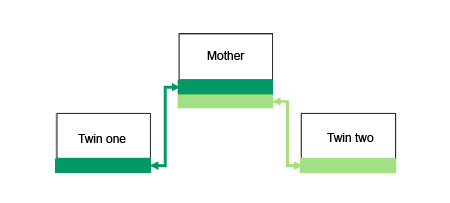IN THIS SITE...

- NHS Maternity Statistics 2005-06
- HES Maternity Data
Maternity data in HES
As the only national data source for normal delivery statistics, gestation periods by birth weight and delivery methods in England, HES is an important resource.
What does it cover?
HES contains data for all births in England, including those at home and in non-NHS hospitals. However records of births outside of NHS hospitals are significantly affected by data quality issues and do not contain information for fields such as admission/discharge date (admidate/disdate) or Patient classification (classpat). Therefore only records for births in an NHS setting are included in the HES Annual Maternity publication. [ONS Birth data should be used for accurately determining birth rates in England.]
Maternity data available from HES includes:
- antenatal and postnatal length of stay
- method of onset of labour
- place of delivery
- anaesthetic/analgesic used before or during delivery
- deliveries with episiotomy
- length of gestation
- gestation period at date first antenatal assessment
- multiple deliveries
- day of week of delivery
- live and still births
- person conducting delivery
- deliveries and births with complications
- miscarriages and ectopic pregnancies resulting in hospital stay (general episodes).
These areas are not only high profile in their own right, but also link to lots of other areas, such as:
- patient choice (normal delivery)
- ethnic group differences (differences in birth weight)
- NHS cost (length of stay in hospital, normal delivery versus elective caesarean, person conducting delivery, and so on).
Inpatient or maternity records?
Most patients admitted to hospital will be classed as general inpatients; even heavily pregnant women admitted to maternity wards with the clear intention of giving birth. However, as soon as the mother has given birth the record becomes a maternity record and is updated before being submitted to HES. If a pregnant woman does not give birth, for whatever reason, before the episode ends, the record will remain as a general inpatient record.
The method of admission field in HES (admimeth) can be used to determine instances where a baby is born en-route to hospital. This may be due to mothers giving birth in the ambulance, or at home while waiting for an ambulance to arrive.
A neonate (a baby up to and including 28 days old) who is kept in hospital and starts a new episode, or who is admitted within the first 4 weeks following birth, is classified as a general inpatient for HES purposes. This includes foundlings (abandoned babies) and neonates admitted for social or economic reasons.
Types of maternity records, baby tails and multiple births
Delivery and Birth episodes in HES can be either consultant episodes or midwife episodes, depending on who has responsibility for the patient.
There are two types of maternity record in HES, the delivery record and the birth record. Both types of record contain an additional 19 fields, known as the baby tail:
- Delivery record: this is the HES record for the mother. It contains the same data as a general record, but has a baby tail for information about the delivery.
- Birth record: this is the HES record for the baby. Again, it has the same format as a general record, but it also has a baby tail containing exactly the same information recorded in the corresponding tail of the delivery record.
In the case of multiple births, the mother's record will have tails for each baby, whereas the birth records will only contain details of the relevant baby tail (see diagram below).
 |
What are well babies?
Most babies born in hospital are alive and healthy, but it is not uncommon for a neonate to suffer from a minor ailment, such as jaundice. Such babies are called 'well babies' as they have a birth record that shows a normal level of nursing care, even though a minor ailment may, in some cases, be recorded in the primary diagnosis field.
For many HES analyses, it is often useful to exclude well babies. To help, HES contains a Well Baby Check Flag, which marks all episodes with a 'Y' for well baby episodes or an 'N' for non-well-baby episodes (this includes all non-well baby episodes, not just birth episodes).
Coverage and data quality
The baby tail data coverage is not as complete as the rest of HES data. There are a number of reasons for the coverage and data quality issues, such as:
- Trusts submitting a significantly higher number of delivery episodes compared to birth episodes
- Trusts failing to submit data on the number of birth episodes where they record a high number of delivery episodes
- Trusts failing to submit delivery - the reason for this is that approximately 20 trusts have a stand alone maternity system which is not linked to the Patient Administration System
- Trusts identifying a high number of maternity beds available, but not recording any information about deliveries or births
- Trusts identifying that they have no maternity beds available, but recording a high number of birth and delivery episodes
- Some trusts have space in their maternity system to record 9 birth tails, whereas other systems have space for 18. As deliveries, miscarriages and abortions are all recorded in the birth tail, there are cases where 9 tails is not enough to record all of the relevant data.
Between 2001-02 and 2005-06, coverage of hospital deliveries was 72.6% on average, whereas that of home deliveries was 13.6% on average. The incomplete coverage problem is significantly compounded by the data quality issues outlined above.
Further information
The HES team is currently investigating trusts that are submitting poor quality maternity data and the Director of Operations at The Information Centre will be writing to the relevant SHAs. In the meantime, users of HES data should contact the HES team ([email protected]) to discuss any potential coverage or data quality issues before undertaking any analysis of HES maternity data.
For more information about HES maternity data, please read the NHS Maternity Statistics reports on the NHS Information Centre website.

